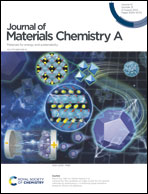Phosphorus doping stabilized LiNi0.83Co0.12Mn0.05O2 with enhanced elevated-temperature electrochemical performance for Li-ion batteries†
Abstract
Ni-rich cathodes LiNixCoyMn1−x−yO2 (0.6 < x < 1) (NCM) with high energy density, environment friendliness, as well as low cost are widely used in Li-ion batteries. Li-ion batteries are required to operate at elevated temperatures in the application of electric vehicles or other special military occasions, which is a huge challenge for battery modules, particularly for batteries with Ni-rich cathodes due to their aggressive side reactions and large lattice volume changes at a high temperature. In this study, the failure mechanism of Ni-rich NCM at high temperatures was systematically investigated. Also, phosphorus doping LiNi0.83Co0.12Mn0.05O2 (Ni83) with excellent high-temperature performance was synthesized via a one-step high temperature diffusion process. Cation mixing is significantly reduced and the phase transformation reversibility evidently improved. As a result, phosphorus doped Ni83 exhibits an extraordinary capacity retention of 80.2% after 500 cycles between 2.7 and 4.3 V at 1C under 60 °C. The full cell also achieves an outstanding cycling stability with a capacity retention of 80.8% after 1000 cycles at 25 °C between 2.7 and 4.3 V.



 Please wait while we load your content...
Please wait while we load your content...